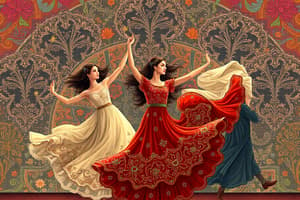Podcast
Questions and Answers
What is the term for the smallest units of form in a dance created by combining multiple movements?
What is the term for the smallest units of form in a dance created by combining multiple movements?
- Unity
- Phrases (correct)
- Motif
- Climax
Which characteristic of a good dance refers to the smooth progression between movements and phrases?
Which characteristic of a good dance refers to the smooth progression between movements and phrases?
- Continuity and development
- Repetition
- Transition (correct)
- Variety and contrast
What does the term 'unity' in dance refer to?
What does the term 'unity' in dance refer to?
- The introduction of new material
- The variety of movements
- The emphasis on climax
- The elimination of unnecessary phrases (correct)
Which characteristic emphasizes the importance of certain movements by repeating them?
Which characteristic emphasizes the importance of certain movements by repeating them?
What is the climax in a dance characterized by?
What is the climax in a dance characterized by?
What does 'variety and contrast' demand in the context of dance?
What does 'variety and contrast' demand in the context of dance?
The characteristic of a good dance that is defined by the organization of phrases is known as?
The characteristic of a good dance that is defined by the organization of phrases is known as?
In dance, what is the role of transitions?
In dance, what is the role of transitions?
Flashcards
Motif
Motif
A short action or gesture that expresses the style and meaning of a dance. It's used, modified, and repeated to develop the choreography.
Form
Form
The arrangement of dance elements in a coherent and harmonious pattern.
Unity
Unity
All movements in a dance must fit together and contribute to the overall concept or idea.
Continuity/Development
Continuity/Development
Signup and view all the flashcards
Variety & Contrast
Variety & Contrast
Signup and view all the flashcards
Transition
Transition
Signup and view all the flashcards
Repetition
Repetition
Signup and view all the flashcards
Climax
Climax
Signup and view all the flashcards
Phrase
Phrase
Signup and view all the flashcards
Study Notes
Dance Characteristics
- MET #2 Dance Characteristics is a topic within Physical Education and Health.
- Smallest units of form are created when multiple movements are merged.
- Phrases are the arrangement or combination of ideas and elements into a coherent pattern. The pattern ends in harmony and continuity, which is important to a good dance.
- Successful choreography has a concept, which can be a short action or gesture. This action expresses the style and meaning of the dance. Dance actions can be reproduced, modified, or augmented by altering the dance elements.
- Motifs are a repeated design or pattern.
Characteristics of a Good Dance
- Unity: Separate movements must fit or flow together, and contribute to the whole dance. Phrases not essential to the concept should be removed.
- Continuity and Development: Movements should progress naturally from one phrase to the next, creating a continuous flow, sweeping the audience along.
- Variety and Contrast: Dance content can be re-used but in a new way, like with a different style or mood, to add variety and contrast. This introduction of new material to a dance helps provide contrast to the existing elements.
- Transition: A transition is the connection between movements, phrases, and sections of a dance. It ensures a smooth flow.
- Repetition: This emphasizes important movements and phrases, creating a sense of closure to a piece.
- Climax: This is the peak of energy in the dance. The climax can show fast energy and action or a quiet exit that marks the end of the dance.
Dance Elements
- Form: The orderly arrangement and purpose of a dance
- Space: Position, movement in space, choreography or staging
- Timing: The rhythm, beat, tempo of the dance
- Energy: Forcefulness of the movement, actions
- Bodily & Group Shape: Physical positioning and formation in the dance
- Phrases: Sections of the dance
- Motif: Repeated design or pattern within a dance
Studying That Suits You
Use AI to generate personalized quizzes and flashcards to suit your learning preferences.




